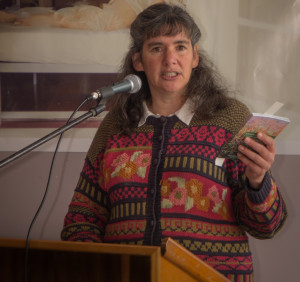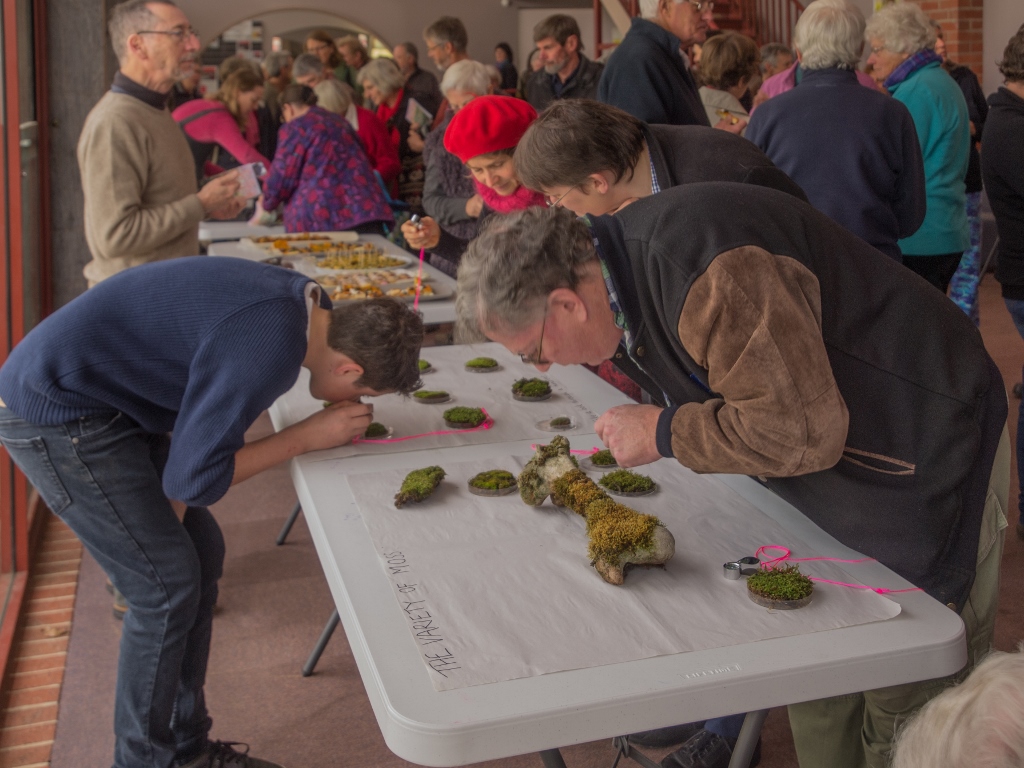Over 100 people packed into the Phee Broadway Theatre foyer last Saturday for the launch of FOBIF’s latest publication, Mosses of dry forests of south eastern Australia. The book was launched by Frances Cincotta, after co author Cassia Read had given a colourful account of the book’s genesis and progress into production.

Frances Cincotta launching Mosses of dry forests…: ‘Mosses are no longer in the too hard basket: they’re in the heavy basket with all the other flora guides where they belong.’
In speaking to the launch of the guide, Frances gave an informative account of the context in which this little book is appearing. We reproduce her talk here:
‘I am delighted to be asked to launch this beautiful little book. I guess I was chosen because of being an enthusiastic promoter of our local indigenous plants since moving to central Victoria in 1990. So I’ve had the privilege of being one of the first to see the finished product of all the labours Cassia has just described. The book is such a pleasure to read, is user-friendly, and helps to fill a gap in our knowledge of local ecosystems. The first thing you notice is the quality and beauty of the photographs.
‘Six photographers have contributed photos to the book including Bernard Slattery and Cassia Read and Cassia has done all the fine drawings. Bernard’s shot on the cover and several others that appear in this book you can see enlarged and framed in an exhibition at Togs right now.
‘But before I talk about the book itself I would like to put this native plant publication into context as I see it through my personal library of valuable references built up over the last 32 years.
‘When I was growing up at Barham I was interested in nature but there were no local field guides in my home or school or local library that would help me understand what I saw out in the local forests. When I left home for Uni at 17 Leon Costermans had just published his excellent book of Trees and Shrubs of South-eastern Australia and that’s the first reference book I bought on native plants and I use it to this day. But he only covered the big, obvious things – trees and shrubs taller than me – they are the dominant life-forms of plant ecosystems and most studied, but we all know there’s so much diversity of plants in our forests and woodlands that are smaller than a human us.
‘As the decades rolled by the number of publications available to help us name and understand all the other species we share this part of the world with has grown: look, I have a whole basketful!
‘In 1994 the VNPA put out a book called the Forgotten Forests describing the common flora of our region. Later after we in the environment movement had all campaigned hard to increase the conservation status of our overlooked forests – this book was republished – now called Victoria’s Box-Ironbark country – a field guide. So the forgotten forests were no longer forgotten, but the smallest plants, those little guys without any vascular system, still did not rate a mention.
‘The Bendigo Native Plant Group put out a Gardeners Guide on using indigenous plants which I was involved in – but moss is not commercially available to gardeners so again these tiny plants on display over here didn’t get a mention.
‘The Bendigo Field Naturalist Club has produced books about local Wildflowers, Eucalypts and one about Orchids.
‘Our own Field Naturalists Club here in Castlemaine has produced many pamphlets covering different groups of local plants such as local Acacias, grasses, Eucalypts, Mistletoes, and most recently a pamphlet about the ‘egg and bacon’ peas and a glossy number on Indigenous plants of Castlemaine. These are all really useful and are all available at the visitor information centre in Castlemaine or at club meetings.
‘Ern Perkins has produced a CD on local grasses, and keeps a comprehensive Castlemaine Plant List up-to-date, but it does not include mosses either. How lucky are to have people in the community like Ern Perkins and Bernard Slattery who instead of putting their feet up in their retirement work on producing these useful resources for us?!
‘There are local weeds field guides, and a few good publications on Victoria’s grasslands.
‘Then Cassia Read moved to this town. I think I first met Cassia when she came to buy indigenous plants from me for her Castlemaine garden. I heard that she was studying for her PhD at the University of Melbourne on the topic “The community dynamics of bio-crusts in semi-arid woodlands of southern Australia”. Always on the lookout for interesting speakers I lined her up to give Newstead Landcare Group a presentation which was very interesting and entertaining (October 2012).
‘This morning Cassia described the other contributors dedication to the task of producing this book, but it would not have happened without her knowledge and interest firing up everyone else. I first noticed the movement on the monthly Friends of Box-Ironbark Forests walks where usually people would be looking for birds or looking at the larger plants as we walked along. However after having their eyes opened to the world of miniature flora by Cassia a good few walkers were now crouching by the side of the path, peering through 10x hand lenses and taking little pressings of moss like earnest detectives.

Part of the crowd at Saturday’s launch. Identifying mosses isn’t so different from identifying other plants: you just have to get a bit closer.
‘It turns out that to identify mosses is similar to identifying any other plant – you need to note where the plant is growing, the shape and arrangement of the leaves, whether the veins are distinct or not, and the shape of the reproductive bits – in this case the spore capsules and its appendages rather than flowers and seedpods.
‘Most people I have known who study for a PhD have had a lonely time of it as they pursue a narrow path in solitude burrowing into a topic in great detail but finding it hard to converse with anyone else about it aside from other academics. Cassia seems to have done it differently, creating around her a gathering of folks interested in her topic and finding time to put into producing this book, a community project, while also nurturing a garden, a partner, and raising 2 children. I think she is amazing!
‘So now at last to add to this growing collection of native plant publications we have Mosses of Dry Forests in south-eastern Australia. Mosses are no longer in the “too hard basket” they are in the now heavy basket here with all the other flora where they belong. These tiny leafy plants that reproduce by spores instead of flowers and seeds and cover perhaps 10 percent of the ground surface have been demystified for us.
‘It says on the back “Written for students and absolute beginners, it’s technically accurate but free of technical language” In fact the language is poetic, it’s inviting. It gets you in. We can all visualise exactly what is meant by tightly overlapping leaves “resembling a plaited pigtail” or shoots stand up “like dishevelled corkscrews’ Another one has mature capsules resembling “tiny, roughly squared drums”, and another’s capsules are like “lollipops”.
’28 distinctive species are illustrated by 3 or 4 excellent photographs, and a line drawing of a leaf with a vertical line next to it showing 1mm for scale. Descriptions include what the moss looks like both wet and as it dries out, also what the capsules look like when they are new and when they are old so that hopefully you can identify mosses when they are at different stages of their lifecycle. 9 more species and described in brief with just one photograph each and 19 more are briefly noted with just a name and where they are found, be it on soil or on rocks or on logs. So it is not comprehensive – you won’t be able to find all the local mosses in here, but it is a perfect way into the topic.
‘One of my favourite photos in the book is by John Walter, of moss on a skull. We learn that Tayloria octoblepharum “favours animal scats or other rich decaying mater where it forms fresh green cushions and turfs. If you notice a yellow green dusting (the spores) on the tip of the capsules, kneel to have a sniff and you’ll get a distinctly unpleasant smell. This apparently attracts flies which carry the sticky spores on their legs to other scats”. How clever is that?
‘I remember a talk Phil Ingamells gave to our FoBIF group years ago about biodiversity and he pointed out that much of the biodiversity of any given ecosystem is in the small, overlooked components such as mosses, fungi and invertebrates yet the most studied parts of the ecosystem are the big things – the vertebrates like us and the big woody trees and shrubs – because they are easy to measure and study. So we thank Cassia for taking that more difficult path of studying the tiny plants and thinking about their role in the health and preservation of our soils, and for sharing that knowledge with us.
‘Why should we even care about mosses? I believe that when we are ignorant about something it’s easy to dismiss it, but when we learn that it has a name, a life cycle, a bird uses this species of moss to disguise her nest or it has a role in nutrient cycling we can begin to appreciate that all the other species we share this part of the world with have their own agendas and roles and mesh together in intricate ways and there is immense pleasure and awe in understanding functioning ecosystems that starts from understanding one component at a time.
‘Finally congratulations to Cassia soon to be Doctor Cassia Read and Bernard Slattery for producing this very useful and very beautiful book and to everyone who has worked on it. I now launch it into the world and hope that it will not sit on dusty bookshelves, but rather be kept in the glove-box or day pack for field trips. Or even just into your backyard to help you learn about the mosses around us. It’s such a great time now for all of us interested in nature compared to when I started out – we have all these tools available to us so I want to encourage you to resource yourselves, and get out there.
‘Thankyou.’




 Click on image for info/order page
Click on image for info/order page Click on image for info/order page
Click on image for info/order page Click on image for info/order page
Click on image for info/order page




















